Beyond "Oppenheimer": An Alternative Watchlist
 Thursday, August 10, 2023 at 10:30AM
Thursday, August 10, 2023 at 10:30AM 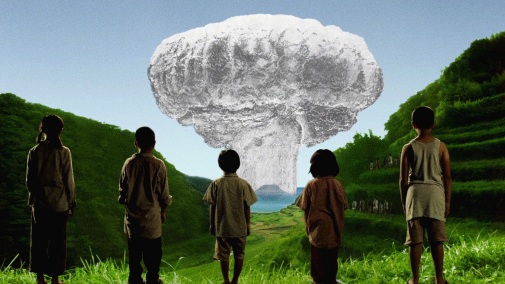 HANAGATAMI (2017) Nobuhiko Obayashi
HANAGATAMI (2017) Nobuhiko Obayashi
On August 6th, 1945, the atomic bomb, nicknamed Little Boy, hit the Japanese city of Hiroshima. On August 9th, a second device, Fat Man, was dropped on Nagasaki. Between those immediately killed in the American attack and the thousands who would perish in the subsequent months, 129,000-226,000 lives were lost, most civilian. Japan had been effectively defeated before the nuclear assault, but the nation's surrender to Allied Forces came on August 15th. According to historians over the decades and high-ranking military of the time, the US needn't have perpetrated such horrors.
And yet, for some, the idea of the bombings as a necessary evil persists. Considering this, one shouldn't be shocked that some viewers came out of Christopher Nolan's latest, grumbling it hadn't done enough to question the narrative. A common complaint is that Oppenheimer doesn't show the effects of the bombings, looking away like its titular character when confronted by such images. But would those images have fit the picture's intentions? Isn't the inability to consider consequences beyond abstraction one of the narrative's central tenets?
As one marks these days of remembrance, it may be more productive to look beyond Oppenheimer and consider Japan's perspective. Perhaps, it's not that Nolan pulled his punches, but that they weren't his to throw…
Building this watchlist of ten, Japanese narrative cinema was the focus, with international productions, American visions, and documentary filmmaking left aside. That said, there's a plethora of works worth your attention among those excluded, including pivotal non-fiction efforts like the 1946-released The Effects of the Atomic Bomb on Hiroshima and Nagasaki and Erik Barnouw's Hiroshima Nagasaki August, 1945. The WGN America series Manhattan, the Day One TV Movie, BBC's Oppenheimer, and Roland Joffé's Fat Man and Little Boy portray a similar milieu to Nolan's movie. They are interesting points of comparison if nothing else.
Without further ado, here's the list, from a controversial double feature to a master director's madcap maximalist swan song.
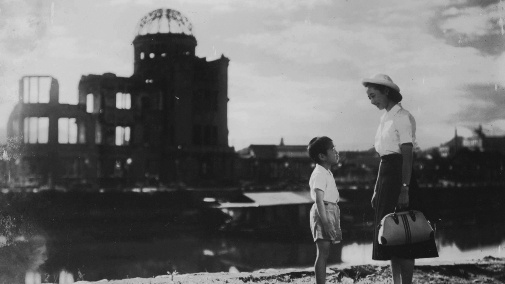
CHILDREN OF HIROSHIMA (1952) Kaneto Shindo
From the time of the Imperial surrender to April 1952, Japan was under American occupation. Among its many effects were constraints on artists, filmmakers bound by censorship, and an inability to confront contemporary issues in the post-war world. The atomic bomb, in particular, was taboo. It's no wonder that, as soon as Allied Forces left, Japanese cinema turned its attention to what was previously forbidden, peering into the trauma of Hiroshima and Nagasaki with newfound freedom. The first of these projects was Kaneto Shindo's Children of Hiroshima, based on survivors' testimony collected in Arata Osada's Children of the Atom Bomb, and commissioned by the Japanese Teacher's Union.
Unburdened by Douglas MacArthur's plans to Americanize Japanese society, the Hiroshima-born director started shooting only a month after the occupation's end and had the film ready for release before the year ended. The city's ruins dominate many of the picture's most memorable images, the carcass of the Prefectural Hall a looming reminder of apocalyptic destruction juxtaposed to the living's resilience, their forward motion into the future. Not that Shindo portrays that movement free-wheeling, his characters trapped in a state of passive immobility as the national tragedy reverberates within their souls.
It's a poetic exercise, introspective and strikingly composed, every frame a painting of deep melancholia. When the blast manifests in dramatized remembrance, it's almost abstract in its devastation, frozen bodies posed in anguish while the elements swirl around them. For a moment, it's as if the impact ruptured the basis of reality itself, the imagery contorting itself in trying to capture inhumane calamity beyond comprehension. As Children of Hiroshima draws to a close, the past recedes, the present's tranquility opening a path forward. However, memory remains impassive and unmovable, a tonal shackle that stops hope from shining uncomplicated. For the Teacher's Union, it wasn't enough.
Although the picture proved successful with Japanese audiences and went on to be selected for Cannes competition, Shindo was heavily criticized as a detached sentimentalist who sacrificed political orientation for tear-jerking pathos. Perhaps in response, the director would return to similar themes in Lucky Dragon No. 5, more open to depicting American culpability and more forceful in its implications. Furthermore, in 1983, Keisuke Kinoshita would go on to make Children of Nagasaki, which shares many structural similarities with its near-homonymous cinematic sibling. The Teacher's Union, however, wasn't content to wait, deciding to start production on a new picture based on the same material.
Children of Hiroshima is streaming on Tubi and FilmBox+.
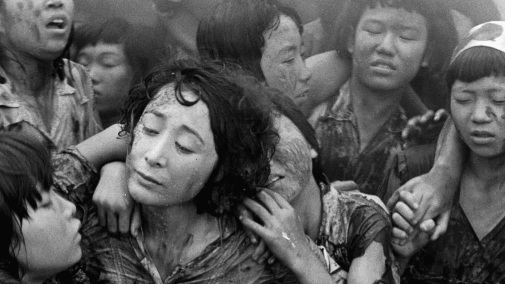
HIROSHIMA (1953) Hideo Sekigawa
If Shindo's film was a lyrical reckoning with interior collective scars echoing the material wreckage of individual lives, Hideo Sekigawa's Hiroshima is a blunt object ready to clobber the spectator with its celluloid nightmare. The original intentions of the Japanese Teacher's Union are here fully realized, complete with agitprop ferocity and fingers pointed straight at American jingoism, hatred, racism. Once again, a teacher's dialogue with their students propels the narrative engine. Only Hiroshima is ready to separate from Eiji Okada's perspective, while Children keeps faithful to Nobuko Otawa's journey through what comes after hell on earth.
There's much to criticize here, from the didactic nature of the script to this clumsy managing of changing POVs, shock being a more critical concern than textual coherence. Going further into its political outcry, the American military is as viciously criticized as the Japanese imperial command, filmstock dripping with pointed disdain for both forces. As one might surmise from such descriptions, the picture had difficulty getting international distribution, needing to be re-edited before it screened in US theaters. However, it kept a considerable fraction of its power, inviting American civilians to behold the human cost of the nuclear bomb, maybe for the first time. Even in Japan, some considered the work too anti-American for wide release.
That's a testament to the picture's power, surely. It's hard to imagine anyone finishing Hiroshima with feelings of indifference in their heart, the central set piece so monumental it comes like a divine hand pressing down on the viewer's conscience. With the aid of up to 90,000 survivors, Hideo Sekigawa reconstructed the pandemonium immediately after the explosion, a mural of suffering that brings to mind what a Bosch painting brought to life might look like. It goes beyond realism, grasping at visceral subjectivity as seen through God's eye, an epic staging of mass pain performed by a cast full of future luminaries. Whatever one might think of it in comparison to Shindo's melancholic piece, Hiroshima is essential viewing.
Hiroshima is currently streaming on the Arrow Player. You can also rent and purchase it on Amazon Video, Google Play, Apple TV, Youtube, and the Microsoft Store.
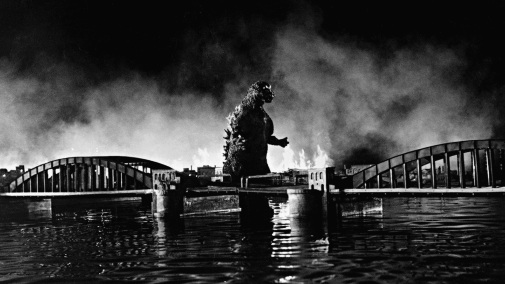
GODZILLA (1954) Ishirō Honda
Beyond direct depictions of the atomic bomb's effects, Japanese cinema has long used allegory as a conduit for self-reflection on a massive scale, getting straight to the heart of the matter by oblique means. Genre trappings are especially handy, as they are in Hollywood, offering a model by which filmmakers can tackle challenging concepts while wearing the costume of easy entertainment. Audiences are thus drawn in, seduced into harsh reckonings, all the more potent because they circumvent the direct depiction of reality. In anime, there are numerous examples of this, reaching its peak in works like Akira.
However, the bomb's haunting is even more intense in kaiju pictures. There's Gamera, Frankenstein Conquers the World, and an array of other titles, but one name reigns supreme. It's Godzilla, of course, and what else can one say about Godzilla in the context of Japan's nuclear trauma? What more can one say about it as a cinematic masterpiece? From the second Akira Ifukube's iconic score starts rumbling on the soundtrack, the movie's off to the races, culminating in the giant reptile's radioactive ravage through reconstructed Tokyo. Its sense of scale is unimprovable, the technical limitations of the production a feature rather than a flaw, conferring immense materiality to its monster story's engine.
Moreover, the human side of things is as riveting as the creature's path, horror mixed with action, an existential threat woven through the tale of a nation trying to contain a destructive force like no other. A tragic scientist represents the intersection of guilt from two sides, the remains of Imperial Japan's rhetoric crossed with the conflicted sentiments of Einstein and Oppenheimer. In another passage, a Nagasaki survivor can be found among the civilians caught in Godzilla's city-obliterating wrath, bemoaning her fate. The script isn't subtle, but it doesn't need to be, its parallels to the A-bomb's trauma and the H-bomb's more recent danger a naked truth.
Godzilla is streaming on Max, the Criterion Channel, Fubo TV, Crackle, Pluto TV, Shout! TV, and the Roku Channel. You can also rent and buy it on Apple TV and Amazon Video.
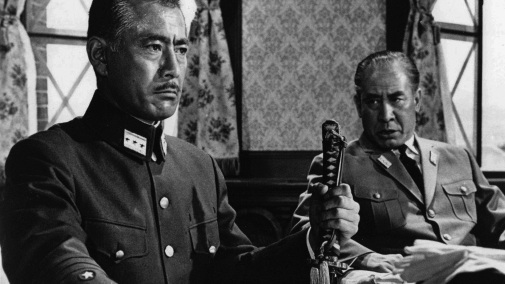
JAPAN'S LONGEST DAY (1967) Kihachi Okamoto
The first dramatizations of the nuclear bombs in Japan's cinema focused on civilian casualties, the lives ended or forever crushed by the flash and bang, the hell the Manhattan Project unleashed. In 1967, as the Japanese New Wave was in full bloom, director Kihachi Okamoto took a different approach, presenting a war film removed from bloodshed, away from war, and into the high echelons that decide the world's fate. It's a political drama through and through, the calamity distant and reported upon by military missives, radio reporting, and other means, so removed from the character's direct experience that absence becomes the picture's critical point.
In that regard, it resembles Oppenheimer more than any other film discussed here, though its scope refuses the biopic's individual analysis. Instead, Japan's Longest Day regards power structures as a system composed of collections of people, detailing historical minutia with archeological attention to detail, its ramifications acted out with excellent fidelity to fact – that's why it extends for 150 minutes composed almost exclusively of dialogue. Skewering Japanese militarism, the film's ardently political, but it also has space to dig into the psychological aspects of its tale, relying on a fantastic cast to imbue dry text with galvanizing emotion.
The burning humiliation of defeat is felt throughout, thanks to these formidable actors falling into the neurosis of bruised egos willing to jeopardize thousands of lives in their games. Another film with a comparable interest in the machinations of the powerful is Sokurov's The Sun, about Emperor Hirohito and featuring a reptilian masterclass turn from Issey Ogata. There's also the Hiroshima Japanese-Canadian coproduction from 1995, which considers the events leading to the first bombing.
Japan's Longest Day is hard to track down. It's not currently streaming anywhere, and English physical media editions are rare. However, there are several Japanese editions on Blu-Ray and DVD, some with multi-language subtitles.
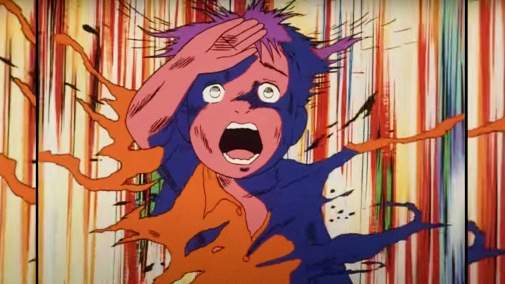
BAREFOOT GEN (1983) Mori Masaki
Future mangaka Keiji Nakazawa was a child living in Hiroshima when the bomb hit. Most of the boy's family was killed in its blazing horror except for his mother and infant sister, who died from malnutrition shortly after. In the 60s, his mother was the one to perish, the long struggle with radiation poisoning coming to an end, grief serving as inspiration for the prodigal son. He started channeling his memories into new work, books detailing survivors' struggle to keep going in a broken cosmos. Then came his most autobiographical effort, and, from 1976 to 1987, the artist authored one of the most important pieces of manga of the 20th century – Barefoot Gen.
Following Nakazawa's in-narrative avatar from the final days of WWII to young adulthood in the 1950s, the series is a harrowing masterpiece, so raw it boggles the mind. Unsurprisingly, it hit the public hard, like a pulverizing punch to the solar plexus. So much so that it went on to become the first full-length manga translation into English to be published in the West. With this level of popularity and historical importance, film adaptations were inevitable, both in anime and live-action. The first of those premiered in 1983, helmed by Mori Masaki and produced by Madhouse, followed by a Toshio Hirata-directed sequel in 1986.
While denying that the picture lives in its literary origin's shadow is impossible, one shouldn't underestimate the adaptation. Barefoot Gen '83 is a brilliant piece of animation, using the simplicity of its chosen style as a boon, setting a game of aesthetic contrast cum contradiction once the bomb shatters the pastoral nostalgia of childhood. That sequence is a rupture in all senses. It leaves the humble register of its early passages for a radical detour into body horror, the armageddon rendered through moving pen on paper. Some sights in the sequence will stay with you, bodies contorting as they melt ashen, earth collapsing as the sky burns bright, exploding glass daggers into flesh.
If possible, the aftermath is even more haunting, a child's perspective of the happenings making taste harsher, innocence galvanizing the bitterness of adult realities. As the black rain comes pouring down, even an act of care turns poisonous, and a mother's love can flash madness in the face of loss. Another animated depiction of this torment can be seen in the Pica-Don short, often shown to Japanese schoolchildren as an educational tool. Though removed from nuclear cruelty, Isao Takahata's Grave of the Fireflies also considers children's plight in times of war, adapted from Akiyuki Nosaka's semi-memoirist short story.
Barefoot Gen is currently streaming on Retro Crush. Barefoot Gen 2 is available on the same platform if you wish to watch the sequel.
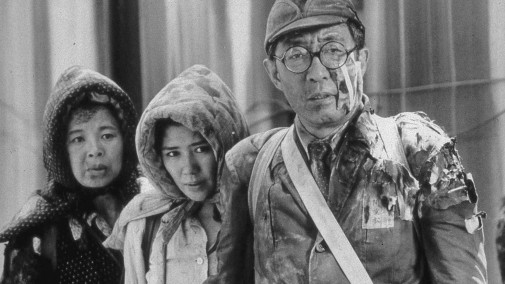
BLACK RAIN (1989) Shôhei Imamura
Perchance the best film in this list, Black Rain is Imamura's grand opus, reaching even greater heights than his Palme d'Or-winning Ballad of Narayama and The Eel. Adapted from Masuji Ibuse's homonymous novel, the film is a family chronicle following the same clan's odyssey of pain in the aftermath of Hiroshima's bombing. The terror of impact is just the beginning, a punishing first act to a much longer story where the quickness of immediate obliteration starts to feel like cosmic kindness in retrospect. The hibakusha's fate is a central point, radiation sickness, an invisible vampire sucking life out of those unlucky enough to hear the blast after the flash, those showered by the titular black rain, those for whom life continued.
Shot in stark silvery monochrome and crisp deep-focus, the film oscillates between docudrama-like portraiture and the material poetry the director so often pursued in his creations, details of the day-to-day life rhyming like verse, reverberating screams in the dark. History moves in grand movements, but the quotidian rhythms dominate Imamura's imagination, even here. Somehow, it hurts most like this. So, it's a tortuous watch, no doubt about it. Still, there's value in the misery, for it's always perceived through a Humanistic lens, acted out with empathetic gentility that's always on the precipice of honest brutality. In two central roles, Yoshiko Tanaka and Kazuo Kitamura are particularly remarkable.
Imamura's vision is one of those that will reside in the viewer's mind for perpetuity. His film is phantasmagoria in 35mm, an exercise that prefers to exorcise the ghosts of the past rather than wallow in melodramatic notions, sentimentality tempered by frankness in execution, performance, text.
Black Rain is currently streaming on the Arrow Player platform. You can also rent and buy it on Amazon Video.
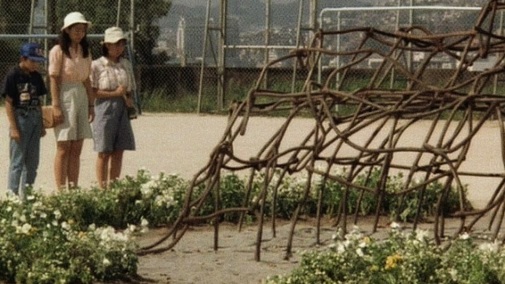
RHAPSODY IN AUGUST (1991) Akira Kurosawa
Atomic anxiety was one of Akira Kurosawa's most persistent preoccupations, seldom expressed in movies past a particular trio. I Live in Fear from 1955 was the first of those, featuring one of the auteur's clumsiest scripts but making up for it with the passion of a true believer trapped in the panic of wanting to be heard by an audience who won't listen. Toshiro Mifune acts his heart out in old age makeup, while Takashi Shimura steals the show in minor key. Later came Dreams, where several of the oneiric chapters concern nuclear and military power turning the world upside down. Whether "Mount Fuji in Red" or "The Weeping Demon," Kurosawa's nightmares make for a disturbing watch.
The last feature came right after Dreams, adapted from a Kiyoko Murata novel and released in 1991, seven years before the director's death. Rhapsody in August isn't Kurosawa's swan song, but it would have made for a fitting farewell, its odd tonalities an alchemic marriage of late style with lacerating urgency. Not that you'd register any haste when contemplating the picture's languid summer rhythms, an accounting of lost days in the warm Nagasaki surroundings, a gaggle of bored kids staying with their grandma. At the same time, the parents visit extended family away in Hawaii. Through generations and the diaspora, a multifaceted portrait bursts through, blooming a flower of keen observations.
In Kurosawa's staging of inaction, we come to recognize different ways in which the blast of the A-bomb manifests. This is true for those who say they've moved on, too, as well as the few who never even thought about family history. Elegant filmmaking suggests a quiet affair, so gentle it might go unnoticed. However, as the characters do, spectators are softly coaxed into more profound reflections, elliptic motions like provocations that elicit troubled reactions. Grappling with the picture's contradictions is part of its experience, a barbed caress touching spirits in front of the screen and within. Simplicity is studied and superficial, a spoonful of honey carrying life-saving medicine.
Rhapsody in August isn't currently streaming online. However, there are a few available physical media editions, including a DVD edited by MGM.
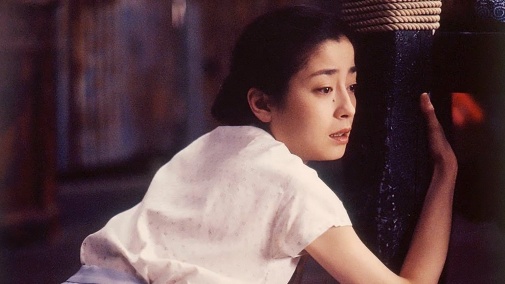
THE FACE OF JIZO (2004) Kazuo Kuroki
Matters of war and responsibility are a common thread through a significant portion of Kazuo Koriki's modest filmography. Such themes extend to the director's penultimate picture, an adaptation of Hisashi Inoue's stage play where a young Hiroshima survivor is visited by her father's ghost when faced with the possibility of romantic love, the start of something new. The action is set three years since the bombing, after the patriarch died, his daughter only escaping the same fate because she happened to be kneeling by a stone pillar as Little Boy ignited. And yet, the gift of life feels wasted in the young librarian, guilt corroding her existence for her luck was just that, dumb and arbitrary, another jolt of senselessness in a world where reason vanished long ago.
Unlike many characters in atomic narratives -the teacher in Children of Hiroshima, for example- The Face of Jizo's heroine consciously refuses to move on, perchance in self-imposed penance or something much harder to pinpoint. The complicated psychology is obfuscated through a performance of precise misdirection, the dialogues between Rie Miyazawa and the ghostly Yoshio Harada unraveling game-like. Each verbal diversion or disarming smile is another brushstroke in Kuroki's painting, the picture's thesis revealing itself in negative space. In the fashion of Kurosawa's Rhapsody in August, the appearance of plainness is but an illusion.
The same dynamic applies to the director's visual idioms, placed between Dreyer's Ordet austerity and canned theater. At first glance, The Face of Jizo is happy to be the play presented with no attempts at opening it up for the screen, sets singing an artificial song and blocking all theatrical. Nevertheless, these aesthetic limits soon become a twin to the character's static states, the camera purposefully deployed rather than existing as a mere recording device. This is a cinema of abnegation, severity interwoven with near-Brechtian intent, a present tense shackled to the past as movement caught by a strike of stillness.
For similar explorations that can function as objects for critical comparison, I'd suggest Alain Resnais' classic Hiroshima Mon Amour, and Kozaburo Yoshimura's Hiroshima Heartache.
The Face of Jizo isn't currently available for streaming. However, you can find many recordings of different renditions of the play on stage. Furthermore, you can import physical media editions in Blu-ray and DVD.
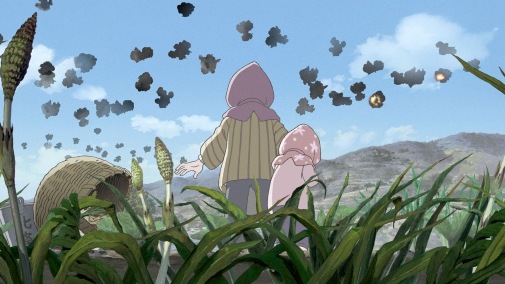
IN THIS CORNER OF THE WORLD (2016) Sunao Katabuchi
Adapted from Fumiyo Kōno's manga, In this Corner of the World is the story of an artist observing the world, the stride of life's difficulties shaping her perspective along the way. It's a tale of grand scope, fashioning itself a fictional biography of young Suzu across ten years, from the 30s to the 40s, in a seaside town near Hiroshima, the historical past lovingly recreated in painterly strokes. Nearly all the backgrounds are watercolor, crafting the environment through the protagonist's hands as if the environments she inhabits have already been philtered down into her drawings, a solipsistic marvel that elevates the picture above similar projects.
Similarly to Takahata's Only Yesterday and its flashback sequences, Sunao Katabuchi approaches Suzu's life as fine art memory. Only that effect is more persistent here, the driving force behind the entire picture instead of a stylization tool to better differentiate narrative realms. The medium aids us in understanding the character whose study one observes, but it also sets a beautiful stage for one of the most unthinkable horrors in Human History. The paradox isn't ignited by the event itself, despite that animation being another poetic flourish diluting literal representation until we're close to total abstraction. Instead, tensions manifest early.
It's the ticking clock feeling that settles over the diarist film once Suzu's ultimate fate becomes apparent. In this construction, the ink-blot dream becomes a watercolor tragedy, a thriller of mundane lives that does double duty as historical piece and depiction of a woman's youth giving in to adulthood. The prettiness of the image is a cushion stuffed with barbed wire, seemingly stopping our fall into horror before tearing the spectator apart. Maybe that's why so many consider this version of the manga more successful than its past live-action adaptations. This epic of seemingly mundane proportions also exists in extended format, resulting in what could be cataloged as the longest animated feature in film history. The director's cut clocks at 168 minutes, while the theatrical version is 129 minutes long.
In This Corner of the World is streaming on Peacock, Hoopla, Freevee, Shout! TV, and the Roku Channel. You can also rent and buy it on Apple TV, Amazon Video, Google Play, Youtube, VUDU, and the Microsoft Store.

LABYRINTH OF CINEMA (2019) Nobuhiko Obayashi
Primarily known as the mad genius behind Hausu, Nobuhiko Obayashi was one of Japanese cinema's most important iconoclasts. A man of avant-garde sensibilities, his films explode with formalistic ideas, mixing mediums and registers with wild abandon, a maximalist expression that's unlike anything else out there. Though not all of his films deal directly with the subject, matters of atomic anxiety run through Obayashi's oeuvre, reflecting the concerns of a man whose youth was spent in Onomichi, so close to Hiroshima that the bomb's blinding flash flooded the city on August 6th, 1945. No wonder he set his last film in an Onomichi movie theater.
But, before we get there, one must contend with the last few years of the auteur's life. By 2012, he had decided to dedicate his work to producing anti-war pictures, starting with Casting Blossoms to the Sky and Seven Weeks. However, this new phase of the artist's career was to be complicated by a lung cancer diagnosis in 2016. Given only a few months to live, the director went into a frenzy, completing his adaptation of Hanagatami in time for a 2017 release, and surviving long enough to try his hand at a final work, a thesis statement to cap an epic filmography. The landmark piece became Labyrinth of Cinema, shot and edited while the director received treatment, trying to prolong his life just a little bit more until the picture was complete.
From the Herculean effort emerged Labyrinth of Cinema, one of the greatest final films in any director's career, encapsulating the artist's total vision through a kaleidoscope of madcap ideas spiraling around an inverse Purple Rose of Cairo scenario. In its deranged narrative, a thunderstorm causes a rupture in reality during a cinema's last screening, transporting an adolescent girl and three strangers into a swirling array of Japanese war pictures. At a certain point, it seems all periods in the nation's history cascade in green screen fakery, a torrent of stimuli edited within an inch of sanity. Only then, a last act emerges with the bombing of Hiroshima on the horizon, fiction within fiction falling into its very own realities and unrealities.
It's hard to describe Labyrinth of Cinema but know it's a masterpiece, the last passages the dash of a lifetime as the artist runs away from death in pursuit of one last glory, one last expression of a nation dealing with the unimaginable torment of the A-bomb. Though its crazy concepts may suggest a cerebral experience, Labyrinth of Cinema is no such thing, nonsense rectifying itself in emotional terms for a lightning bolt to pierce your heart, soul, pure imagination. By the end of it, exhaustion wracks you as a viewer. Still, if you're like me, a feeling of catharsis will also spring forth, the ecstasy of a Humanistic masterpiece intent on showing all the possibilities of cinema before the end of all ends.
You can rent or buy Labyrinth of Cinema on Amazon Video.
Do you think Nolan should have shown the bombings in Oppenheimer, or would you rather see other filmmakers tackle the topic?



Reader Comments (6)
No THE FACE OF ANOTHER?
Thanks for the article, from this list I've only seen Godzilla and Rhapsody, so I'll try to check the other ones.
Black Rain is currently on MUBI right now.
My perspective on this as an Asian is conflicted. Granted the horrors of the atomic bombing was unspeakable, but as someone from a country that the Japanese ravaged in World War II, I know the horrors they unleashed for three years or more in my country and others were also abominable. Is there a tit for tat involved in circumstances of war?
I studied in Japan in my early 20s, and actually visited Hiroshima. I went to the A-Bomb Museum, and I was flabbergasted by the way the exhibit glossed over the atrocities Japan did during the War. No mention at all of the carnage they did in my country and others. I went to Hiroshima with the spirit of love and healing, genuinely outraged by the bomb, but I left feeling angry.
Nolan would always be damned if he did and damned if he didn't. The latter because, as we've seen, people think filmmakers need to spell this sort of stuff out. The former because if he did, many would say he had no right to take on that. But, yeah, there's plenty of movies from this perspective if people complaining about Oppenheimer genuinely cared, but i suspect they don't because, ew, old movies and ew subtitles.
Utilize xManager download for Spotify Apk to acquire the reputable Spotify version suitable for your region or device, offering all available variants. Krnl executor as a robust Roblox executor, prioritizing script efficiency, stability, and minimal crashes for dependable performance.